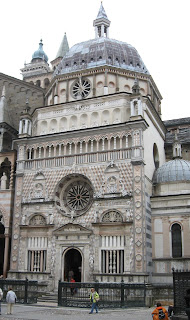 |
| The Monument to the Partisan by Giacomo Manzù can be found in Piazza Matteotti |
One of Manzù's most notable works, his Monument to the Partisan, can be found in Piazza Matteotti in the Città Bassa, a short distance from Porta Nuova.
The 3.2m (10ft 6ins) bronze sculpture shows a young anti-Fascist partisan fighter hanging upside down by his feet, having supposedly been tortured to death by Italian Fascists or Nazi soldiers. Alongside him stands a young woman looking on in sadness.
On the reverse is a poem written by Manzù, dedicated to the partisan.
Manzù presented the work to his home city on its completion and it was unveiled on April 25, 1977.
The son of a shoemaker, Angelo Manzoni, who was also sacristan of the parish church of Sant’Alessandro in Colonna, Manzù taught himself to be a sculptor, helped only by a few evening classes in art, and went on to achieve international recognition.
He changed his name to Manzù and started working in wood while he was doing his military service in the Veneto in 1928.
After moving to Milan, he was commissioned by the architect, Giovanni Muzio, to decorate the Chapel of the Sacred Heart Catholic University.
But he achieved national recognition after he exhibited a series of busts at the Triennale di Milano. The following year he held a personal exhibition with the painter, Aligi Sassu, with whom he shared a studio.
 |
| Sculptor Giacomo Manzù was the son of a Bergamo shoemaker |
Manzù had started teaching at the Accademia di Brera in Milan, but during the war he went back north to live in Clusone, to the north of Bergamo, in Val Seriana. He returned to teach in Milan at the end of the war.
Manzù then moved to Salzburg, where he met his wife, Inge Schabel, who became the model for several of his sculptures.
He built an 11-foot high sculpture, Passo di Danza, in Detroit and his last great work was a six-metre tall sculpture of a woman with a child outside the United Nations headquarters in New York in 1989.
During his long career he also built stage sets for the composer Igor Stravinsky and he eventually designed his tomb in Venice.
A devout Catholic, Manzù was a personal friend of Angelo Giuseppe Roncalli, who would go on to be Pope John XXIII and who was also from Bergamo, and he completed some important commissions for the Vatican and St Peter’s Basilica.
 |
| Pio Manzù, Giacomo's son, who died tragically young in 1969 |
While in Rome he lived in Ardea, south of the capital and close to the sea, in a locality that has since been renamed Colle Manzù un his honour. Ardea has a museum dedicated to his work.
Manzù died in Rome in 1991, The New York Times described him in an obituary as ‘one of Italy’s leading sculptors whose work often mixed religious, allegorical and sexual imagery’.
Sadly, he outlived his son, Pio, by 22 years. Pio, who was also born in Bergamo, was a successful designer whose work in the automobile industry yielded the groundbreaking Fiat 127, the "people's car" of Italy in the 1970s. His death at the age of just 30 in a road accident in 1969, however, meant he did not live to see the project completed.




















